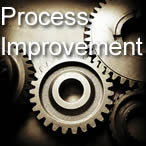Process Improvement – Essential Steps
Improving business processes requires companies to first understand their existing processes. While this sounds obvious, senior management will often stipulate that a particular process or series of processes need to be improved based upon their understanding of these processes. However, their understanding and the reality at the coal-face, are more often than not, miles apart.
In order to improve any operational process and provide greater customer value, the process first needs to be understood, and the easiest way to understand a process is by drawing or mapping it. So, step 1 is to map the existing process and gain consensus that “this is how we do it”, i.e. the “current” state. Once you’ve mapped your “current” state, it is essential to then map your “future” and “ideal” states, where the former is how you envisage the revised processes to be in the short to medium term. The “ideal” represents the ultimate long-term goal (perfection), which should serve as a guide or reminder for future improvement efforts.
Following the above steps gives companies an opportunity to critically examine what they are doing and identify where processes can be improved. These maps allow one to ask critical questions about the individual tasks within the processes, and so identify areas of waste, or opportunities for improvement, e.g.
- Does the current process always generate the desired results?
- What is being done that does not need to be done?
- Why are goods/documents being stored here?
- Why are the goods/documents etc being stored for such a long time?
- Why is this task necessary and why is it being done by this person/department?
- Can we re-arrange the physical layout of the department/office/factory/shop etc, to reduce the amount of movement and facilitate flow?
- Can we eliminate, simplify or combine this task with another?
- Is this task actually adding customer value?
- Why does this task take so long?
- Can we group these people/departments/tasks together?
- Are we giving the customer what he really wants or only what is available?
- Is this report necessary, who uses it, and for what purpose?
- Are we using metrics that will allow us to improve the process or customer value?
- Why do these tasks result in scrap components or process errors?
- How can we eliminate or reduce the scrap rate or processing errors?
- Can we eliminate duplicated information by improved IT systems?
- Can we use technology to improve the process?
- Can we locate operations/tasks next to each other to reduce time/movement?
- How can we improve the customer’s experience by reducing the time from order to delivery?
- What can we automate and what should remain manual?
Implementing IT and other automated solutions should only be considered after the above steps have been completed. Failure to do so, can, and often does, lead to “automating the existing state of chaos”. Improving business processes often includes a significant IT component, and one must be wary of simply outsourcing the responsibility of implementing these changes to the IT department, or worse still, to an external provider. While IT staff are typically highly skilled and competent people, do they really know and understand the business processes better than the actual users?
To give yourself the best chance of success, start with clear idea of what you want to achieve (future state), then improve existing processes before automating, and finally, make sure that the people at the coal-face are part of the process improvement team/s.
For more information call 1300 348 811 or email info@informgroup.com.au








